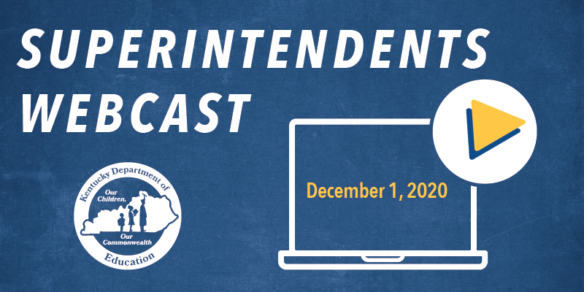
- Schools must reallocate other federal funds to pay for what FEMA will no longer reimburse.
- A vaccine for COVID-19 is coming, but there won’t be enough to vaccinate teachers at first.
By Jim Gaines
jim.gaines@education.ky.gov
Kentucky’s school superintendents learned Dec. 1 during the Kentucky Department of Education’s (KDE) monthly Superintendents’ Webcast that federal rules on reimbursement for some COVID-19-related costs have changed.
Robin Kinney, associate commissioner in KDE’s Office of Finance and Operations. said the new FEMA guidance seems to make more restrictive the ability to request reimbursement for protective gear, temperature scanners and disinfectant from Federal Emergency Management Agency (FEMA) relief funds.
Other federal funds for COVID-19 costs must be exhausted before FEMA money is used, Kinney said. The new guidance was posted on KDE’s webpage.
KDE has sent a letter to Kentucky’s Congressional delegation asking for the rule change to be reconsidered, she said, noting districts who were counting on reimbursement of some costs through FEMA now must reallocate other federal fund sources to cover them.
In late November the U.S. Department of Education reported that several states, including Kentucky, had not spent most of their Coronavirus Aid, Relief, and Economic Security (CARES) Act money for schools. In Kentucky’s case that’s not true, Kinney said. Much of the money is being used to purchase technology that hasn’t arrived yet, she said.
COVID-19 Status and Vaccine
Commissioner of Education Jason E. Glass told superintendents that when school districts are allowed to resume in-person classes, they need to keep following Healthy at School guidance.
Gov. Andy Beshear suspended in-person classes in public and private schools by executive order, starting Nov. 23 until Dec. 7 for grades K-5, and for grades 6-12 until Jan. 4.
Grades 6-12 will not be allowed back in schools until Jan. 4, but grades K-5 may return Dec. 7 provided they are no longer in a “red zone county” as defined by the Kentucky Department for Public Health (DPH) and continue following the Healthy at School guidance.
Gov. Beshear deliberately made no decision yet as to whether schools can choose to reopen following Jan. 4 if their community infection rates are still high, Glass said. That determination likely will be made based on statewide COVID-19 rates at the time and how schools in other states that have remained open are doing, he said.
Kentucky is doing better than surrounding states in number of COVID-19 infections, but since late September the number of cases, related intensive care admissions and patients on ventilators have steadily climbed, said Dr. Connie White, DPH deputy commissioner.
When the Pfizer two-dose vaccine becomes available, Kentucky will get fewer than 40,000 doses in the first round of distribution, White said. It has not yet been fully tested for use in children. Kentucky’s first doses will go to healthcare providers and nursing home residents, though there won’t be enough to vaccinate them all, she said.
The vaccine itself will be free, and health officials will work to vaccinate the most vulnerable first, White said.
“With only 40,000 doses we’re going to make a start,” she said. Educators are in the second category for distribution, but so are many other professions such as first responders, White said. More than 70,000 doses of a second vaccine developed by Moderna are expected later.
Until most of the population can be vaccinated, more months of “hands, face and space” mitigation – handwashing, wearing face masks and social distancing – will be necessary, she said.
Targeted Services Guidelines
While schools are closed to in-person classes, they still are allowed to bring in small groups of students for targeted services that can’t be delivered remotely, said Kelly Foster, associate commissioner in KDE’s Office of Continuous Improvement and Support.
Eligible services include:
- Evaluation;
- Necessary hands-on experiences;
- Mental health or academic counseling;
- Occupational, physical or speech therapy; and
- Targeted remediation or tutoring.
Schools should not exceed a total school capacity of 15% of their usual student building capacity and should have no more than 15 individuals in a classroom at any given time, including adults, Foster said. The time a student can spend in the building is limited to two hours, and Healthy at School guidelines must be observed.
The exemption is not to be used for bringing in general groups of students for primary instruction, she said.
KDE is recommending districts keep providing meals on a to-go basis only, said Lauren Moore, KDE division director for Schools and Community Nutrition. If students must be fed during targeted services, those meals should be provided as “grab-and-go” in a bag and taken to the classroom. Districts must have a system in place to make sure those meals do not duplicate those already provided by the school, Moore said. Details are available on KDE’s Schools and Community Nutrition webpage.
Educational Resources
For parents and educators of special education and preschool students, there are many resources on distance learning available on KDE’s Special Education Instructional Resources webpage, said Veronica Sullivan of KDE’s Office of Special Education and Early Learning.
For fall 2020 professional learning, there are four modules in the Teaching and Learning PL Series: Eliciting Evidence of Learning, said Micki Ray, policy adviser in the KDE Office of Teaching and Learning, Division of Program Standards. They cover methods of assessment, learning goals and criteria for success.
The last of those modules will be released on Dec. 9, along with multiple supplemental resources, she said.
Student Participation
Kentucky schools must accurately record student participation to measure student engagement in lieu of in-person attendance data, said David Cook from the KDE Office of Continuous Improvement and Support.
“It’s crucial that inside Infinite Campus (IC) you have your students properly set up,” he said, and teachers should check to ensure their students all are correctly entered.
Since this year’s school funding is not tied to participation rates, accurate participation records are primarily of value to the individual school districts, allowing them to track students, Cook said.
Digital Learning Coaches
More than 50 school districts already have received funding through a stipend match for building a statewide Digital Learning Coach network, said Marty Park, chief digital officer KDE’s Office of Education Technology. It is designed to help educators and administrators develop and improve online instruction methods. For more information, go to the KDE Digital Learning webpage.
The program is open to all districts, and signup continues, Park said.
“We do want every single school district to participate in that stipend match program,” he said.



Leave A Comment